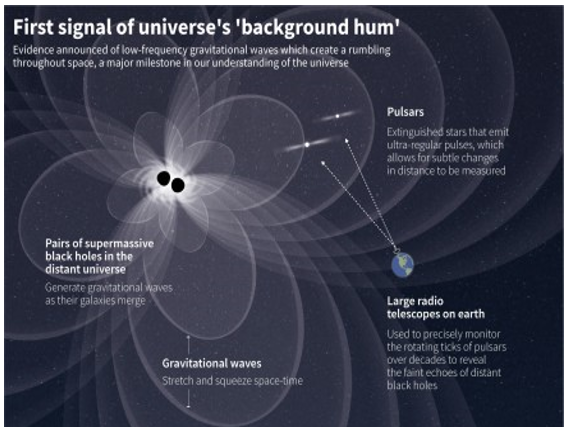- Courses
- GS Full Course 1 Year
- GS Full Course 2 Year
- GS Full Course 3 Year
- GS Full Course Till Selection
- Online Program
- GS Recorded Course
- NCERT (Recorded 500+ Hours)
- Polity Recorded Course
- Geography Recorded Course
- Economy Recorded Course
- AMAC Recorded Course
- Modern India, Post Independence & World History
- Environment Recoded Course
- Governance Recoded Course
- Science & Tech. Recoded Course
- International Relations and Internal Security Recorded Course
- Disaster Management Module Course
- Ethics Recoded Course
- Essay Recoded Course
- Current Affairs Recoded Course
- CSAT
- 5 LAYERED ARJUNA Mentorship
- Public Administration Optional
- ABOUT US
- OUR TOPPERS
- TEST SERIES
- FREE STUDY MATERIAL
- VIDEOS
- CONTACT US
GRAVITATIONAL WAVE BACKGROUND OF THE UNIVERSE
GRAVITATIONAL WAVE BACKGROUND OF THE UNIVERSE
30-06-2023

Latest Context
Recent discoveries by scientists point to the existence of low-frequency gravitational waves, disturbances in the space-time fabric that Albert Einstein's General Theory of Relativity predicted more than a century ago.
Facts About Gravitational Waves:
- In 2015, an experiment utilising Laser Interferometer Gravitational Observatory (LIGO) detector made the first observation of gravitational waves.
- But the waves had a high frequency, and it is thought that they were created 1.3 billion years ago when two relatively tiny black holes merged.
- For many years, researchers have been searching for low-frequency gravitational waves. Such waves, in their opinion, are constantly moving through space like background noise.
- Throughout the cosmos, pairs of supermassive black holes in the centres of galaxies collide and produce gravitational waves. This discovery offers sufficient evidence to contend that our universe contains a gravitational wave background.
- Radio astronomers from five distinct worldwide teams, including the Indian Pulsar Timing Array (InPTA), employed completely different methods to find low-frequency gravitational waves.
- Researchers examined pulsars, which are far-off fast spinning neutron stars that release pulses of radiation that are seen from Earth as dazzling flashes of light, using six big radio telescopes across the globe, including the one in Pune.
- Scientists utilise pulsars as "cosmic clocks" because these bursts occur at regular intervals.
- Scientists have claimed that the observed discrepancies were created by abnormalities in space-time generated by gravity waves after studying 25 pulsars over a period of 15 years. These anomalies demonstrated recurrent impacts of gravitational waves.
- It is important for understanding how gravity works as well.
- One of the six huge telescopes in the globe that was crucial in presenting evidence was the Giant Metrewave Radio Telescope (GMRT, Pune), which is operated by India.
- The other five are in Germany, the United Kingdom, France, Italy, and the Netherlands.
Facts about LIGO
- The gravitational waves (also known as ripples in space-time) caused by the movement of massive astronomical objects like planets and stars are detected by LIGO, an international network of labs.
- Albert Einstein's general theory of relativity, which encompasses our present knowledge of how gravitation operates, initially proposed these waves.
- Multiple orders of magnitude smaller distance changes than the length of a proton is detectable by the LIGO detectors.
- Light beams are simultaneously released into both compartments to conduct the experiment. The light should often return to both chambers simultaneously.
- But when a gravitational wave comes through, one chamber lengthens while the other contracts, causing a phase difference in the light waves that come back. The discovery of this phase difference establishes the gravitational wave's existence.
What is Space-time?
In his Special Theory of Relativity, Einstein argued that the three dimensions of space (height, breadth, and depth) and the one dimension of time are actually one continuous four-dimensional continuum known as space-time.
Must Check: IAS Coaching Centre In Delhi



